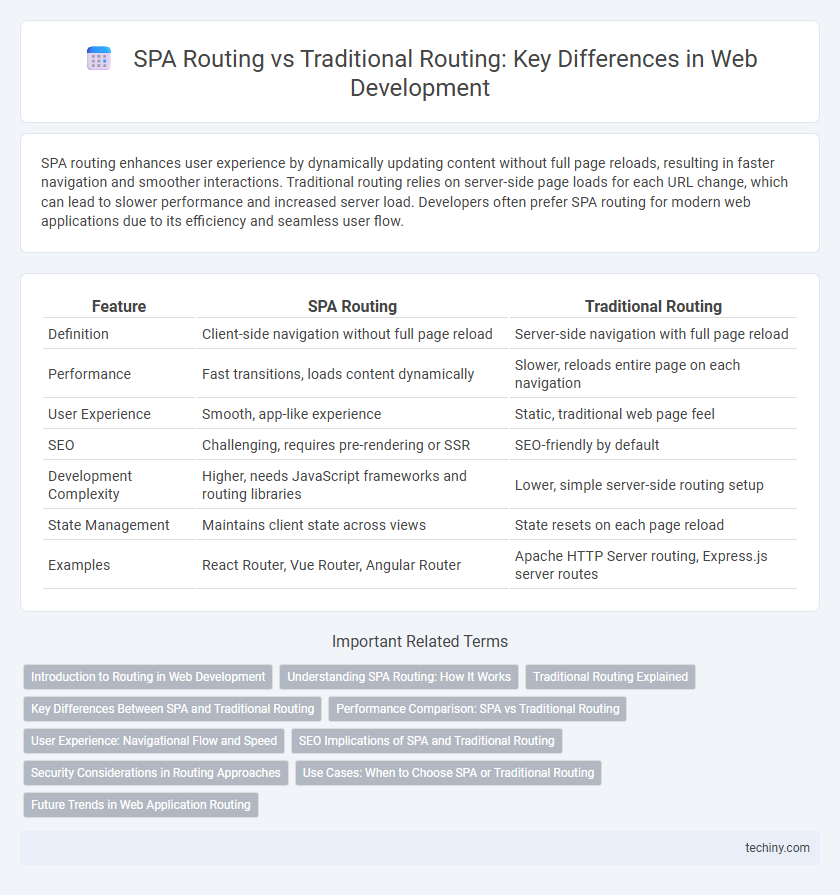SPA routing enhances user experience by dynamically updating content without full page reloads, resulting in faster navigation and smoother interactions. Traditional routing relies on server-side page loads for each URL change, which can lead to slower performance and increased server load. Developers often prefer SPA routing for modern web applications due to its efficiency and seamless user flow.
Table of Comparison
| Feature | SPA Routing | Traditional Routing |
|---|---|---|
| Definition | Client-side navigation without full page reload | Server-side navigation with full page reload |
| Performance | Fast transitions, loads content dynamically | Slower, reloads entire page on each navigation |
| User Experience | Smooth, app-like experience | Static, traditional web page feel |
| SEO | Challenging, requires pre-rendering or SSR | SEO-friendly by default |
| Development Complexity | Higher, needs JavaScript frameworks and routing libraries | Lower, simple server-side routing setup |
| State Management | Maintains client state across views | State resets on each page reload |
| Examples | React Router, Vue Router, Angular Router | Apache HTTP Server routing, Express.js server routes |
Introduction to Routing in Web Development
Routing in web development enables navigation between different views or pages. Traditional routing relies on full page reloads handled by the server, while Single-Page Application (SPA) routing loads content dynamically without refreshing the entire page. SPA routing enhances user experience by providing faster transitions and reduces server load through client-side rendering.
Understanding SPA Routing: How It Works
SPA routing leverages client-side JavaScript to dynamically update the browser's URL and content without reloading the entire page, providing a seamless user experience. Unlike traditional routing, which relies on server requests for each page load, SPA uses history API or hash-based methods to manage navigation within a single page. This approach significantly reduces latency and enhances performance by minimizing server interactions while maintaining navigational state.
Traditional Routing Explained
Traditional routing in web development involves loading a new HTML page from the server with each user navigation, causing a full page refresh and increased load times. This method relies on the server to handle URL requests and render the entire page, impacting performance and user experience. Traditional routing is simple to implement and SEO-friendly but lacks the smooth, dynamic experience provided by Single Page Applications (SPA).
Key Differences Between SPA and Traditional Routing
Single Page Application (SPA) routing dynamically updates the browser URL without reloading the entire webpage, relying heavily on client-side JavaScript frameworks like React or Angular to manage navigation and state. Traditional routing involves full-page reloads as each URL request is sent to the server, which then delivers a complete HTML page, resulting in slower transitions and higher bandwidth usage. SPA routing enhances user experience by providing faster interactions and smoother transitions, while traditional routing maintains better SEO and simpler server architecture.
Performance Comparison: SPA vs Traditional Routing
Single Page Applications (SPAs) offer faster navigation by dynamically updating content without full page reloads, significantly improving performance compared to traditional routing, which requires reloading the entire webpage on each route change. SPAs leverage client-side rendering and asynchronous data fetching to minimize server requests and reduce latency, enhancing user experience with smoother transitions. In contrast, traditional routing relies on server-side rendering, often resulting in increased load times and higher bandwidth usage due to repeated loading of static resources.
User Experience: Navigational Flow and Speed
Single-page application (SPA) routing enhances user experience by enabling instantaneous navigational flow without full page reloads, resulting in faster interactions and smoother transitions. Traditional routing relies on server requests for each page change, causing noticeable delays and disrupting the seamless flow users expect. Optimizing SPA routing with client-side frameworks like React Router or Vue Router significantly reduces latency, improving overall speed and responsiveness in web applications.
SEO Implications of SPA and Traditional Routing
Single Page Application (SPA) routing often relies on client-side rendering, which can hinder SEO performance as search engines may struggle to index dynamically loaded content effectively. Traditional routing uses server-side rendering, delivering fully populated HTML pages to crawlers, resulting in better SEO outcomes due to improved visibility and faster content recognition. Implementing server-side rendering or hybrid solutions like SSR with SPA frameworks can mitigate SEO challenges associated with SPA routing.
Security Considerations in Routing Approaches
Single Page Application (SPA) routing relies on client-side navigation, which necessitates stringent security measures such as validating route changes and preventing client-side injection attacks. Traditional routing involves server-side URL handling, inherently providing stronger control over access restrictions and mitigating risks like unauthorized resource access. Proper implementation of authentication and authorization mechanisms is essential in both approaches to protect sensitive data and maintain application integrity.
Use Cases: When to Choose SPA or Traditional Routing
Single Page Application (SPA) routing is ideal for platforms requiring dynamic user experiences with minimal page reloads, such as social media sites, dashboards, and real-time data applications. Traditional routing suits content-heavy websites like blogs, news portals, or corporate sites where SEO and server-side rendering are critical. Choosing SPA routing enhances performance and fluidity for interactive applications, while traditional routing ensures better accessibility and SEO for static or content-centric websites.
Future Trends in Web Application Routing
Future trends in web application routing emphasize increased adoption of Single Page Application (SPA) routing due to its seamless user experience and faster load times by dynamically updating content without full page reloads. Emerging frameworks leverage client-side routing combined with server-side rendering (SSR) and incremental static regeneration (ISR) to optimize performance and SEO simultaneously. Advances in WebAssembly and edge computing further enhance routing efficiency by enabling near-instant content delivery and complex logic execution closer to users.
SPA routing vs traditional routing Infographic

 techiny.com
techiny.com